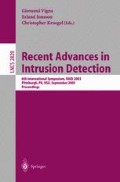Abstract
Most deployed intrusion detection systems (IDSs) follow a signature-based approach where attacks are identified by matching each input event against predefined signatures that model malicious activity. This matching process accounts for the most resource intensive task of an IDS. Many systems perform the matching by comparing each input event to all rules sequentially. This is far from being optimal. Although sometimes ad-hoc optimizations are utilized, no general solution to this problem has been proposed so far.
This paper describes an approach where machine learning clustering techniques are applied to improve the matching process. Given a set of signatures (each dictating a number of constraints the input data must fulfill to trigger it) an algorithm generates a decision tree that is used to find malicious events using as few redundant comparisons as possible.
This general idea has been applied to a network-based IDS. In particular, a system has been implemented that replaces the detection engine of Snort [14,16]. Experimental evaluation shows that the speed of the detection process has been significantly improved, even compared to Snort’s recently released, fully revised detection engine.
This work has been supported by the FWF (Fonds zur Förderung der wissenschaftlichen Forschung), under contract number P13731-MAT. The views expressed in this article are those of the authors and do not necessarily reflect the opinions or positions of the FWF.
Access this chapter
Tax calculation will be finalised at checkout
Purchases are for personal use only
Preview
Unable to display preview. Download preview PDF.
References
Aho, A., Corasick, M.: Efficient string matching: An aid to bibliographic search. Communications of the Association for Computing Machinery 18, 333–340 (1975)
Cisco IDS - formerly NetRanger (2002), http://www.cisco.com/warp/public/cc/pd/sqsw/sqidsz/index.shtml
Jason Coit, C., Staniford, S., McAlerney, J.: Towards Faster String Matching for Intrusion Detection or Exceeding the Speed of Snort. In: Proceedings of DISCEX 2001 (2001)
Eckmann, S.T., Vigna, G., Kemmerer, R.A.: STATL: An Attack Language for State-based Intrusion Detection. In: Proceedings of the ACM Workshop on Intrusion Detection Systems, Athens, Greece (November 2000)
Fisk, M., Varghese, G.G.: An analysis of fast string matching applied to contentbased forwarding and intrusion detection. Technical Report UCSD TR CS2001- 0670, UC San Diego (2001)
Hartmeier, D.: Design and Performance of the OpenBSD Stateful Packet Filter (pf). In: USENIX Annual Technical Conference – FREENIX Track (2002)
Lee, W., Stolfo, S., Mok, K.: A Data Mining Framework for Building Intrusion Detection Models. In: Proceedings of the IEEE Symposium on Security and Privacy, Oakland, CA (May 1999)
MIT Lincoln Labs. DARPA Intrusion Detection Evaluation (1999), http://www.ll.mit.edu/IST/ideval
Moore, J.S., Boyer, R.S.: A Fast String Searching Algorithm. Communications of the Association for Computing Machinery 20, 762–772 (1977)
Paxson, V.: Bro: A system for detecting network intruders in real-time. In: 7th USENIX Security Symposium, San Antonio, TX, USA (January 1998)
Quinlan, J.R.: Discovering rules by induction from large collections of examples. In: Expert Systems in the Micro-Electronic Age, Edinburgh University Press (1979)
Quinlan, J.R.: Induction of decision trees. Machine Learning 1(1), 81–106 (1986)
RealSecure., http://www.iss.net/products_services/enterprise_protection
Roesch, M.: Snort - Lightweight Intrusion Detection for Networks. In: USENIX Lisa 1999 (1999)
Snort-NG. Snort - Next Generation: Network Intrusion Detection System, http://www.infosys.tuwien.ac.at/snort-ng
Snort. Open-source Network Intrusion Detection System, http://www.snort.org
Sourcefire. Snort 2.0, http://www.sourcefire.com/technology/whitepapers.htm
Swatch: Simple Watchdog, http://swatch.sourceforge.net
Symantec - NetProwler and Intruder Alert (2002), http://enterprisesecurity.symantec.com/products/products.cfm?ProductID=%50
Vigna, G., Eckmann, S., Kemmerer, R.A.: The STAT Tool Suite. In: Proceedings of DISCEX 2000, Hilton Head, South Carolina, January 2000, IEEE Computer Society Press, Los Alamitos (2000)
Author information
Authors and Affiliations
Editor information
Editors and Affiliations
Rights and permissions
Copyright information
© 2003 Springer-Verlag Berlin Heidelberg
About this paper
Cite this paper
Kruegel, C., Toth, T. (2003). Using Decision Trees to Improve Signature-Based Intrusion Detection. In: Vigna, G., Kruegel, C., Jonsson, E. (eds) Recent Advances in Intrusion Detection. RAID 2003. Lecture Notes in Computer Science, vol 2820. Springer, Berlin, Heidelberg. https://doi.org/10.1007/978-3-540-45248-5_10
Download citation
DOI: https://doi.org/10.1007/978-3-540-45248-5_10
Publisher Name: Springer, Berlin, Heidelberg
Print ISBN: 978-3-540-40878-9
Online ISBN: 978-3-540-45248-5
eBook Packages: Springer Book Archive

